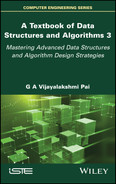Summary of Volume 1
- Preface
- Acknowledgments
- Chapter 1. Introduction
- 1.1. History of algorithms
- 1.2. Definition, structure and properties of algorithms
- 1.2.1. Definition
- 1.2.2. Structure and properties
- 1.3. Development of an algorithm
- 1.4. Data structures and algorithms
- 1.5. Data structures – definition and classification
- 1.5.1. Abstract data types
- 1.5.2. Classification
- 1.6. Algorithm design techniques
- 1.7. Organization of the book
- Chapter 2. Analysis of Algorithms
- 2.1. Efficiency of algorithms
- 2.2. Apriori analysis
- 2.3. Asymptotic notations
- 2.4. Time complexity of an algorithm using the O notation
- 2.5. Polynomial time versus exponential time algorithms
- 2.6. Average, best and worst case complexities
- 2.7. Analyzing recursive programs
- 2.7.1. Recursive procedures
- 2.7.2. Apriori analysis of recursive functions
- 2.8. Illustrative problems
- Chapter 3. Arrays
- 3.1. Introduction
- 3.2. Array operations
- 3.3. Number of elements in an array
- 3.3.1. One-dimensional array
- 3.3.2. Two-dimensional array
- 3.3.3. Multidimensional array
- 3.4. Representation of arrays in memory
- 3.4.1. One-dimensional array
- 3.4.2. Two-dimensional arrays
- 3.4.3. Three-dimensional arrays
- 3.4.4. N-dimensional array
- 3.5. Applications
- 3.5.1. Sparse matrix
- 3.5.2. Ordered lists
- 3.5.3. Strings
- 3.5.4. Bit array
- 3.6. Illustrative problems
- Chapter 4. Stacks
- 4.1. Introduction
- 4.2. Stack operations
- 4.2.1. Stack implementation
- 4.2.2. Implementation of push and pop operations
- 4.3. Applications
- 4.3.1. Recursive programming
- 4.3.2. Evaluation of expressions
- 4.4. Illustrative problems
- Chapter 5. Queues
- 5.1. Introduction
- 5.2. Operations on queues
- 5.2.1. Queue implementation
- 5.2.2. Implementation of insert and delete operations on a queue
- 5.2.3. Limitations of linear queues
- 5.3. Circular queues
- 5.3.1. Operations on a circular queue
- 5.3.2. Implementation of insertion and deletion operations in circular queue
- 5.4. Other types of queues
- 5.4.1. Priority queues
- 5.4.2. Deques
- 5.5. Applications
- 5.5.1. Application of a linear queue
- 5.5.2. Application of priority queues
- 5.6. Illustrative problems
- Chapter 6. Linked Lists
- 6.1. Introduction
- 6.1.1. Drawbacks of sequential data structures
- 6.1.2. Merits of linked data structures
- 6.1.3. Linked lists – structure and implementation
- 6.2. Singly linked lists
- 6.2.1. Representation of a singly linked list
- 6.2.2. Insertion and deletion in a singly linked list
- 6.3. Circularly linked lists
- 6.3.1. Representation
- 6.3.2. Advantages of circularly linked lists over singly linked lists
- 6.3.3. Disadvantages of circularly linked lists
- 6.3.4. Primitive operations on circularly linked lists
- 6.3.5. Other operations on circularly linked lists
- 6.4. Doubly linked lists
- 6.4.1. Representation of a doubly linked list
- 6.4.2. Advantages and disadvantages of a doubly linked list
- 6.4.3. Operations on doubly linked lists
- 6.5. Multiply linked lists
- 6.6. Unrolled linked lists
- 6.6.1. Retrieval of an element
- 6.6.2. Insert an element
- 6.6.3. Delete an element
- 6.7. Self-organizing lists
- 6.8. Applications
- 6.8.1. Addition of polynomials
- 6.8.2. Sparse matrix representation
- 6.9. Illustrative problems
- 6.1. Introduction
- Chapter 7. Linked Stacks and Linked Queues
- 7.1. Introduction
- 7.1.1. Linked stack
- 7.1.2. Linked queues
- 7.2. Operations on linked stacks and linked queues
- 7.2.1. Linked stack operations
- 7.2.2. Linked queue operations
- 7.2.3. Algorithms for Push/Pop operations on a linked stack
- 7.2.4. Algorithms for insert and delete operations in a linked queue
- 7.3. Dynamic memory management and linked stacks
- 7.4. Implementation of linked representations
- 7.5. Applications
- 7.5.1. Balancing symbols
- 7.5.2. Polynomial representation
- 7.6. Illustrative problems
- 7.1. Introduction
- References
- Index
..................Content has been hidden....................
You can't read the all page of ebook, please click here login for view all page.
